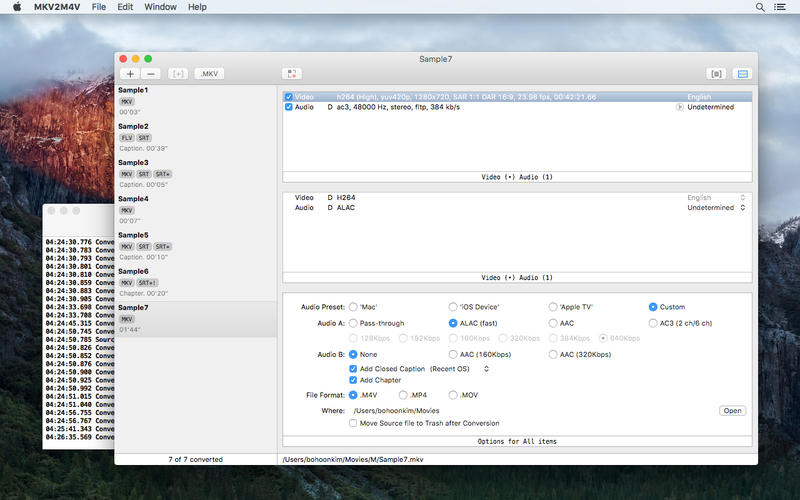

One feature of MD5 checksums is that even minor changes to the input file will create drastic changes in the resulting checksum. At this point there was no bash scripting or application to help, we simply opened up the MD5 sidecar files in TextEdit and made the comparison manually. audiomd5.įrom here it’s just a matter of comparing the MD5 of the MKV and MOV streams. Likewise, the second script finds all of the MKV and MOV files in a folder and creates an MD5 of only the audio stream ( -vn tells ffmpeg to ignore the audio stream) and then places it in a sidecar file with the extension. The first script finds all of the MKV and MOV files in a folder and creates an MD5 of only the video stream ( -an tells FFmpeg to ignore the audio stream) and then places it in a sidecar file with the extension. This was done for an entire batch of files using a single-line bash script:įor file in *.mkv do ffmpeg -i “$file” -movflags write_colr -c:v v210 -color_primaries smpte170m -color_trc bt709 -colorspace smpte170m -color_range mpeg -metadata:s:v:0 “encoder=Uncompressed 10-bit 4:2:2” -c:a copy -vf setfield=bff,setsar=40/27,setdar=4/3 -f mov “$.audiomd5” done The first thing we did was use FFmpeg to transcode from FFV1/MKV to v210/MOV. But of course, we didn’t want to simply trust the manual, we wanted to test every step of the process and be confident that the videos we transferred from the analog to the digital realm would survive another migration, an entirely digital one this time, completely intact.īatch Migration from FFV1/MKV to v210/MOV At this point, we had a serious question to contend with: How do we go from FFV1/MKV to MOV while ensuring that no data is lost or damaged in the process? If FFV1’s lossless compression is what it claims to be, then we should be able to go from FFV1/MKV to MOV with no issues. How can we ensure that this conversion is lossless?Īll of our excitement about FFV1/MKV led us to a moment when we were just so excited about being able to support MKV in our own workflows that we created files for a collection holder that actually wanted MOV files. That being said, we do feel that the FFV1/MKV format is extremely powerful, and try to offer it as a deliverable when discussing formats with collection holders that have the resources and training necessary to fully support it. The digital preservation advantages of FFV1/MKV are very powerful, but the amount of space saved for smaller projects (many of the collections we process contain less than 30 hours of video content) may not outweigh the technical hurdles involved in using and supporting FFV1/MKV. Since many collections we work with come either from organizations or individual artists, the question of moving to FFV1/MKV can be somewhat difficult to tackle.

However, in the case that the collection holder is ambivalent about their deliverables and asks us to make the decision for them, this is the default configuration. Master Files: Uncompressed 10-Bit 4:2:2 MOVĬollection holders can choose different formats for their Master files, or can decide not to receive the Mezzanine or Access files. Instead, this blog post will describe our process of converting FFV1/MKV files to v210/MOV files while ensuring that no data is lost or mangled in the resulting files.įor the most part, our typical delivery package looks like this: Literature about the benefits, adoption, and capture of MKV have already been written, so we’ll skip that for now. We often try to walk the thin line between helping collection holders make decisions about their master formats and being as flexible as possible to provide them with their desired formats. At BAVC Media Preservation one of our main objectives is to digitize tape-based media formats to preservation-ready digital files.


 0 kommentar(er)
0 kommentar(er)
